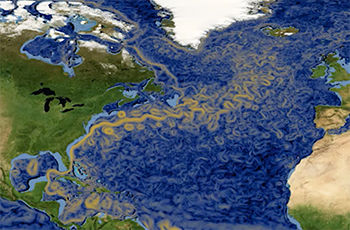Multiple drivers of the North Atlantic warming hole
The Atlantic meridional overturning circulation (AMOC) transports heat from the tropics to the North Atlantic and thereby has a substantial effect on European climate and weather. In recent decades the sup-polar North Atlantic has been observed to cool despite global warming, a phenomenon known as the North Atlantic warming hole. A number of studies have attributed the warming hole to the declining AMOC, although direct measurements of the AMOC have only been available since 2004.
Paul Keil and colleagues show with their simulations that the link between low latitude AMOC and the warming hole is more complex than previously thought. They use the MPI Grand Ensemble to analyse the warming hole for different scenarios of greenhouse gas forcing, and with large amount of ensemble members they are able to account for the impact of natural variability in the North Atlantic. The authors find that the warming hole – AMOC relationship depends considerably on greenhouse gas forcing and can change over time. The authors explain this by examining changes in ocean circulation more closely: Besides the reduced heat import from the south associated with the low latitude AMOC, the heat transport by the subpolar gyre circulation as well as the overturning north of the warming hole acts to increase the heat transport out of the region. Moreover, in simulations of the historical period, the low latitude AMOC shows no significant changes, while the high latitude heat transport clearly increases, from which the authors conclude that the observed warming hole should be attributed to these high latitude changes instead of the low latitude AMOC.
Finally, the authors perform additional simulations, in which the effect of changing clouds was excluded, a mechanism which has not been previously considered as driver of the warming hole. These simulations, in which clouds don’t change under the influence of global warming, produce a slightly weaker warming hole, revealing that a cloud feedback has a small but discernible impact on the warming hole. The surface cooling produces more low-level clouds, which act to reflect more solar radiation, which further increases the surface cooling.

Original publication
Keil, P., T. Mauritsen, J. Jungclaus, C. Hedemann, D. Olonscheck and R. Ghosh (2020) Multiple drivers of the North Atlantic warming hole. Nature Climate Change, https://doi.org/10.1038/s41558-020-0819-8
Contact:
Paul Keil
Max Planck Institute for Meteorology
Phone: +49 (0) 40 41173 386
Email: paul.keil@mpimet.mpg.de
Dr Johann Jungclaus
Max Planck Institute for Meteorology
Phone: +49 (0) 40 41173 109
Email: johann.jungclaus@mpimet.mpg.de
